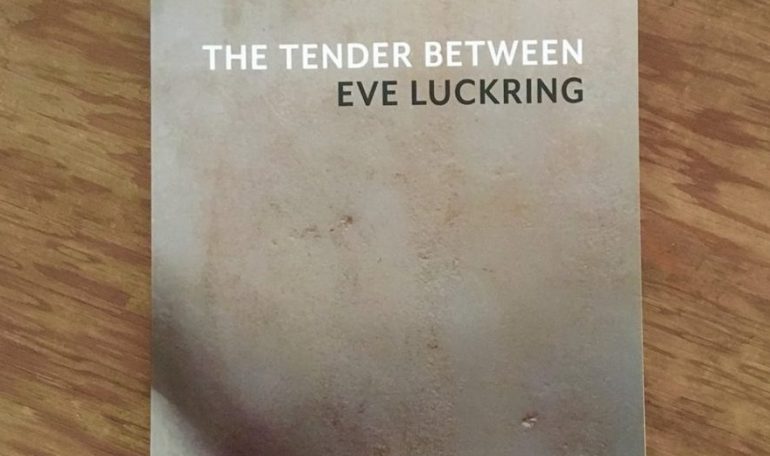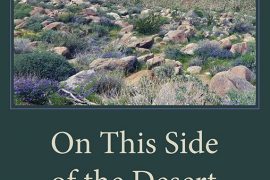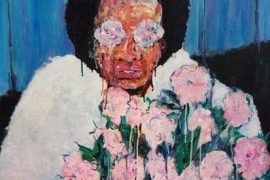A Review of Eve Luckring’s The Tender Between that Begins and Ends Nearly as Many Times as the Book Has Sections
Ornithopter Press, 2018
The first page of Eve Luckring’s The Tender Between is almost blank, save for the page number, one word, and one small piece of punctuation; set a third of the way down the page and standing out against all the off-white surrounding it, the solo word’s comma gently rounds it off while also leading the reader’s eye right into the rest of this marvelously crafted book, by the end of which the word will have repeated several times with little additions in each instance—eventually accreting into an entire six-strophe poem!—but beginning, simply, thus:
[perfectpullquote align=”full” bordertop=”false” cite=”” link=”” color=”” class=”” size=””]Becoming,[/perfectpullquote]
Becoming is exactly what The Tender Between exhibits, tracks, and makes visible over the course of its 106 pages. Luckring’s ranging collection of untitled, fragmentary poems tells of many things, perhaps none more so than the complicated relationship between the part and the whole — this is a never-ending story for Luckring’s poetics, and one to which every person, every object, every word and every sound contributes its part. As the back of the book (designed by Mark Harris for Ornithopter Press, for which TTB is the first full-length title after an impressive run of gorgeous, hand-produced, single-run chapbooks) avers, “[t]his is a spare, precise poetry attentive to every syllable” — and it is also a poetry that is unfailingly attentive to the astonishing variety of objects and personae that populate its world.
***
The Tender Between has a unique compass helping it to navigate its way backward through time, touching (as it does) on literary forebears from Beckett to Bashō and bearing (as it does) dual epigraphs from Ogiwara Seisensui and Penny Harter. The Harter epigraph is actually the entirety of a small poem from her 1984 book In The Broken Curve:
[perfectpullquote align=”full” bordertop=”false” cite=”” link=”” color=”” class=”” size=””]broken bowl
the pieces
still rocking[/perfectpullquote]
Luckring’s closeness to the world of ideas in this three-line grain of sand — the many skittish and periodic movements of partiality, the stark power of one bare image, the double meaning of “still” always almost-pausing time as it manages to continue inexorably forward — is evident everywhere in The Tender Between. To borrow a phrase repeated severally in the text, these poems are “never known whole” — they resort to everything from visual/formal experiment to metapoetic gesture to motifs that almost seem to make wholes of the book’s myriad parts, without attempting to close any one section off fully or completely. All the while the prevailing brokenness presaged in the Harter epigraph rocks on, sometimes gathering enough momentum to surge into Eros:
[perfectpullquote align=”full” bordertop=”false” cite=”” link=”” color=”” class=”” size=””]throbbing stars —
the tilt
of my pelvis[/perfectpullquote]
I do not think it is the case that, for Luckring, partiality or incompleteness must lead inevitably to a longing for some greater whole; sometimes the parts just lie there rocking, like the pieces of Harter’s bowl. Other times, when intense desiring-moments erupt into the text as above, it is not the whole that Luckring’s speaker is seeking — it is the complex resonances a part might find in the co-materiality of yet another part.
***
Luckring’s book has the chimerical ability to channel the multiple valences of its images in many different directions at once. The most erotic section of The Tender Between — also its shortest, certainly its most dense — begins with an image that doesn’t exactly reek of sex, and instead feels almost like a Dutch still life compressed into one line:
[perfectpullquote align=”full” bordertop=”false” cite=”” link=”” color=”” class=”” size=””]open scissors beside a vase of water[/perfectpullquote]
Of course, almost anything’s potential can be made active through desire, and you will have to buy the book to read the raw lyric magic Luckring works in the wake of this innocuous prepositional phrase. Each of the sections in The Tender Between is animated by one or more small trajectories like this, made possible by the many different potentials latent in Luckring’s carefully-chosen images.
***
With possibility, too, comes uncertainty, and sometimes also anxiety and fear. In one of the book’s haibunesque prose segments, the speaker notes that the sound of a crow perched on her neighbor’s satellite dish “has the timbre of the earthquake alarm in the building where [she teaches]”. This is a far cry from any eroticized mating call, or perhaps it’s the dark flipside of eroticism itself— the constant, real, and harrowing proximity of violence, domestic and otherwise.
Perhaps the book’s strangest section to my ear is the middle one, the site of a mélange of proper nouns from post-9/11 America (“Qandahar”, “Abu Ghraib”, “American Dream”, “Pentagon”) and common nouns from the digital lifeworld we increasingly inhabit (first the near-neutral “memory”, then a score of spondees: “touch [/] screen”, “clickbait”, “plugged in”, “sign in”, “back door” — then the almost playful “cookies” and Tinder-meets-Dora-the-Explorer “swiping”). In a way this all makes perfect sense: Luckring is an accomplished video artist, and no medium does more than video to bridge the gap between contemporary American mass media and the liquid modernity of omnipresent social networking.
Here is a quote by Luckring on a video installation of hers, entitled Chicken, which consists of a large 36’-by-9’ screen in a warehouse space displaying three different simultaneous video projections of chickens running around, complete with the sounds of chickens squawking fed into the warehouse from all directions:
Yes. I was thinking about the gestures and the movement and the sound and the installation of the fractured screens as reflecting our contemporary lifestyles: this constant “look here, look there” running around; this anxious rush through things and no focus. And there’s this anti-climax, when one of the chickens makes this feeble attempt to fly. Nothing culminates in the end and then the video loops back round to the beginning. What I attempted to do is bring the visual experience to a visceral level for viewers, so that in the gut, affected by sight and sound, they are feeling something that may be difficult to articulate, but will take them to this other place.
I was a reader of Luckring’s poetry before coming to know her video work, and this quote felt totally apt as a description of what Luckring accomplishes so successfully in her poems, which work “in the gut” and traffic in precisely those things which “may be difficult to articulate, but will take them [—Luckring’s readers, her experiential contemporaries who can bring these poems to life with their own voices—] to this other place.”
***
Here is a line from the book that I will not attempt to contextualize or otherwise intrude upon, a line that I feel lucky to be alive to have seen written, and one I hope will make you stop anything you might be doing so you can read it aloud and savor all its little musics:
[perfectpullquote align=”full” bordertop=”false” cite=”” link=”” color=”” class=”” size=””]so greenly history puts forth thorns[/perfectpullquote]
***
There is more, much more, in The Tender Between than any one review can hope to properly laud. We have barely said anything about Luckring’s excursions into prose or her virtuosic use of the space of the page, and nothing at all about the recurring, talismanic presences in the book of certain animals (the crow, sure, but also all the other flying creatures, i.e. birds and bats and moths) as well as of the matheme (“< a cat [/] > a carcass”, “an irreducible fraction of a woman dividing by zero”). We are a far cry, too, from giving a full account of the feminist genealogy of Luckring’s poetics — it’s not all Beckett and Bashō, surely; Armantrout is here too, and perhaps also Hejinian and Scalapino.
The reviewer and reader, like Luckring’s speaker, have to live in the myriad resonances of the partial, a midway kind of being that Luckring gives us a remarkably rich vocabulary to describe. When you read this book (as I hope in absolute earnest you will), maybe you will also struggle to articulate the pluriform ways it makes you feel, only to find in the very text a line that helps you locate yourself in all that feeling, one that says succinctly what it means to slip into a brilliant, ephemeral new poetry that feels as beautiful as it is gently mysterious:
[perfectpullquote align=”full” bordertop=”false” cite=”” link=”” color=”” class=”” size=””]at the edge of the sea entering the barely there[/perfectpullquote]





